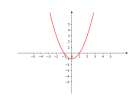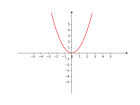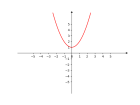更多操作
我们经常用不等式来研究含有不等关系的问题.
基本事实
如果 [math]\displaystyle{ a - b \gt 0 }[/math], 那么 [math]\displaystyle{ a \gt b }[/math]
如果 [math]\displaystyle{ a - b = 0 }[/math], 那么 [math]\displaystyle{ a = b }[/math]
如果 [math]\displaystyle{ a - b \lt 0 }[/math], 那么 [math]\displaystyle{ a \lt b }[/math]
反过来也成立. 即
[math]\displaystyle{ a \gt b \Leftrightarrow a - b \gt 0 }[/math]
[math]\displaystyle{ a = b \Leftrightarrow a - b = 0 }[/math]
[math]\displaystyle{ a \lt b \Leftrightarrow a - b \lt 0 }[/math]
所以,如要证明 [math]\displaystyle{ x \le a }[/math], 只需证明 [math]\displaystyle{ x - a \le 0 }[/math] 即可.
基本不等式
把不等式 [math]\displaystyle{ \frac{a + b}{2} \ge \sqrt{ab}(a \gt 0, \; b \gt 0) }[/math] 称为基本不等式.
对任意 [math]\displaystyle{ a, b \in R, a^2 + b^2 \ge 2ab }[/math],当且仅当 [math]\displaystyle{ a = b }[/math] 时等号成立.
对任意正数 [math]\displaystyle{ a, b, \frac{a + b}{2} \ge \sqrt{ab} }[/math],当且仅当 [math]\displaystyle{ a = b }[/math] 时等号成立.
一般地,对于正数 [math]\displaystyle{ a,\; b }[/math],我们把 [math]\displaystyle{ \frac{a + b}{2} }[/math] 称为 [math]\displaystyle{ a,\; b }[/math] 的算术平均数,[math]\displaystyle{ \sqrt{ab} }[/math] 称为 [math]\displaystyle{ a,\; b }[/math] 的几何平均数.
拓展结论
- 已知 [math]\displaystyle{ x, \; y }[/math] 都为正数,如果 [math]\displaystyle{ xy }[/math] 等于定值 [math]\displaystyle{ P }[/math],那么当且仅当 [math]\displaystyle{ x = y }[/math] 时,和 [math]\displaystyle{ x + y }[/math]有最小值 [math]\displaystyle{ 2 \sqrt{p} }[/math];
- 如果 [math]\displaystyle{ x + y }[/math] 是定值 [math]\displaystyle{ s }[/math],那么当且仅当 [math]\displaystyle{ x = y }[/math] 时,积 [math]\displaystyle{ xy }[/math] 有最大值 [math]\displaystyle{ \frac{s^2}{4} }[/math].
由此可总结出:
当两个正数变量的积或和为定值时,他们的和有最小值或积有最大值
糖水原理
[math]\displaystyle{ a }[/math] 克糖水中有 [math]\displaystyle{ b }[/math] 克糖,
它的质量分数就是 [math]\displaystyle{ \frac {b}{a} }[/math].
再向容器中加入 [math]\displaystyle{ c }[/math] 克糖,
得到质量分数为 [math]\displaystyle{ \frac{b+c}{a+c} }[/math] 的糖溶液.
加入两次糖后的溶液更甜,即后者质量分数更大.
即
[math]\displaystyle{ \frac {b}{a} \lt \frac {b + c}{a + c} }[/math].
证明过程
其中,[math]\displaystyle{ a \gt b \gt 0, \; c \gt 0 }[/math].
作差证明:
[math]\displaystyle{ \frac {b}{a} - \frac {b + c}{a + c} = \frac {ab + bc - ab - ac}{a(a + c)} = \frac {bc - ac}{a(a + c)} = \frac {c(b - a)}{a(a + c)} \lt 0 }[/math]
所以 [math]\displaystyle{ \frac {b}{a} \lt \frac {b + c}{a + c} }[/math].
一元二次不等式
与二次函数的关系
一元二次方程根的分布/二次函数的零点分布(卡根法)
| 分布情况 | 两个负根 即两根都小于 0
[math]\displaystyle{ (x_1 \lt 0, x_2 \lt 0) }[/math] |
两个正根 即两根都大于 0 | 一正根一负根 即一根小于 0,一根大于 0 |
|---|---|---|---|
| 大致图象 [math]\displaystyle{ (a\gt 0) }[/math] | <图象> | <图象> | <图象> |
| 得出的结论 |
| 分布情况 | 两个负根 即两根都小于 0 | 两个正根 即两根都大于 0 | 一正根一负根 即一根小于 0,一根大于 0 |
|---|---|---|---|
| 大致图象 (a<0) | <图象> | <图象> | <图象> |
| 得出的结论 |
例题
基本不等式
用一段长为 [math]\displaystyle{ 36\,\text{m} }[/math] 的篱笆围成一个矩形菜园.
- 当这个矩形的边长为多少时,所用篱笆最短?最短篱笆的长度是多少?
- 当这个矩形的边长为多少时,菜园的面积最大?最大面积是多少?
解:设矩形菜园的相邻两条边的长分别为 [math]\displaystyle{ x\,\text{m}, y\,\text{m} }[/math],则篱笆的长度为 [math]\displaystyle{ 2(x + y)\,\text{m} }[/math].
1.
- 由已知,得 [math]\displaystyle{ xy = 100 }[/math],
- 根据基本不等式 [math]\displaystyle{ \frac{x + y}{2} \geq \sqrt{xy} }[/math],
- 可得 [math]\displaystyle{ x + y \geq 2\sqrt{xy} = 2\sqrt{100} = 20 }[/math],
- 所以,[math]\displaystyle{ 2(x + y) \geq 40 }[/math]
- 当且仅当 [math]\displaystyle{ x = y = 10 }[/math] 时,上式等号成立.
- 因此,当这个矩形菜园是边长为 [math]\displaystyle{ 10\,\text{m} }[/math] 的正方形时,所用篱笆最短,最短篱笆的长度为 [math]\displaystyle{ 40\,\text{m} }[/math].
2.
- 由已知,得 [math]\displaystyle{ 2(x + y) = 40 }[/math],矩形菜园的面积为 [math]\displaystyle{ xy\,\text{m}^2 }[/math].
- 根据基本不等式可得 [math]\displaystyle{ \sqrt{xy} \leq \frac{x + y}{2} = \frac{18}{2} = 9 }[/math],
- 所以,[math]\displaystyle{ xy \leq 81 }[/math].
- 当且仅当 [math]\displaystyle{ x = y = 9 }[/math] 时,上式等号成立.
- 因此,当这个矩形菜园时边长为 [math]\displaystyle{ 9\,\text{m} }[/math] 的正方形时,菜园面积最大,最大面积是 [math]\displaystyle{ 81\,\text{m}^2 }[/math].



